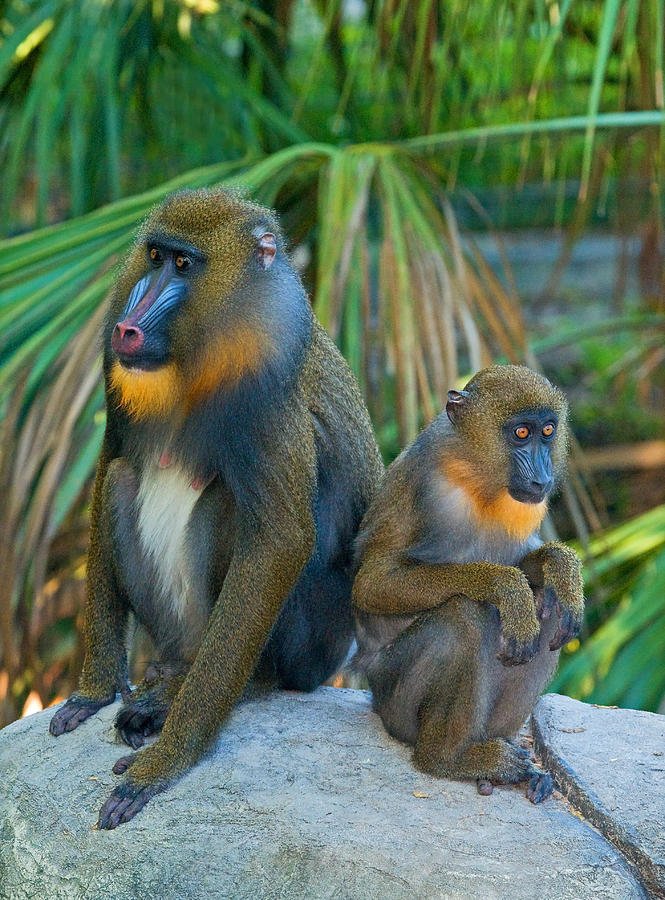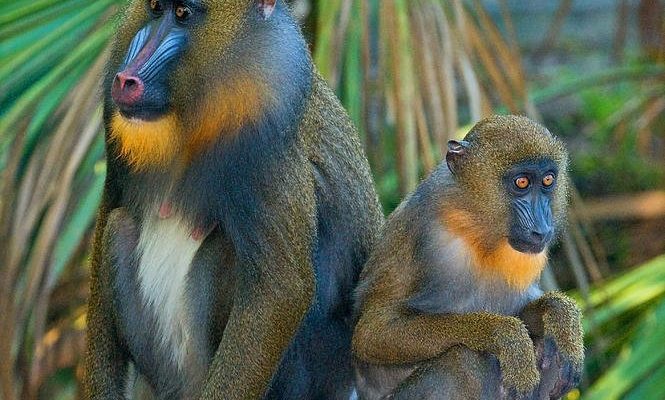
Mandrills live in some tough conditions where food isn’t always abundant and predators are ever-present. Their survival strategies are a mix of physical adaptations, social behaviors, and clever foraging techniques. Let me explain how these vibrant creatures manage to not only survive but also flourish in challenging environments.
Physical Adaptations to Harsh Environments
Mandrills are hefty animals, with adult males weighing up to 120 pounds. This size is not just for show; it plays a vital role in their survival. The robust physique helps them navigate through dense underbrush, making it easier to find food and escape from threats. Their strong limbs and sharp claws allow them to climb trees, a key strategy for evading ground predators and finding fruits and leaves high above.
But it’s not just their size that matters. Mandrills have distinctive, multi-colored faces and rumps, which aren’t just for attracting mates—they also play a role in their social interactions. These vibrant colors help them communicate with each other, especially in the dim light of their forest habitat. When a mandrill is feeling threatened or excited, the brightness of their face can signal their emotional state to others in the troop. This communication is crucial in avoiding conflicts and maintaining group cohesion, which is vital for survival.
Diet and Foraging Skills
Food availability is a major concern for mandrills living in harsh environments. Fortunately, these primates are omnivores, meaning they eat a wide variety of foods. Their diet consists mainly of fruits, seeds, and leaves, but they also consume insects and small animals when the opportunity arises.
One of their clever foraging strategies involves using their strong sense of smell. Mandrills can detect ripe fruits from a distance. This ability allows them to optimize their foraging time and minimize energy spent searching for food. When food is plentiful, they can eat their fill, but during leaner times, they tolerate the occasional tough meals, such as bark or leaves, that other animals might overlook. It’s a resourceful way to keep their energy up, especially when resources run low.
Social Structure and Group Dynamics
Here’s the thing: survival is often easier when you’re not going it alone. Mandrills live in large social groups called troops, which can include up to 200 individuals. This social structure plays a crucial role in their survival. Living in a troop offers protection from predators. With so many eyes scanning the treetops and ground, it’s much harder for a single predator to catch a mandrill off-guard.
Within these groups, there’s a clear hierarchy, with dominant males usually getting the first pick of food and mating opportunities. However, the social bonds formed among members also have a protective function. Troop members groom each other and exhibit behaviors that strengthen their relationships, which can decrease stress and promote overall group stability. Strong social ties help mandrills thrive in difficult times, as they can rely on each other for support.
Adaptability to Environmental Changes
You might be wondering how mandrills cope with changes in their environment. These primates are incredibly adaptable. When faced with deforestation or human encroachment, they can adjust their foraging habits and even their social structures.
For example, mandrills have been observed migrating to new areas in search of food when their original habitat becomes unsuitable. This adaptability is crucial, especially as climate change and habitat destruction continue to threaten their environments. By being flexible and resourceful, mandrills demonstrate an impressive ability to survive, even when faced with daunting challenges.
Predator Evasion Techniques
Mandrills have a few tricks up their sleeves when it comes to avoiding predators like leopards and large birds of prey. Their primary strategy revolves around their keen senses and their choice of habitat. By living in dense forests, mandrills can quickly disappear among the foliage. This camouflage is essential for avoiding detection.
When a threat is detected, mandrills will often make loud calls to warn others in the troop. This alarm system helps keep everyone aware of potential dangers. Additionally, they have learned to be careful about when and where they forage, preferring to stick to areas where they can spot trouble coming from a distance. This cautious behavior showcases their intelligence and strategic thinking, both essential for surviving in the wild.
Climate Resilience
As global weather patterns shift, many animals struggle to adapt. However, mandrills show remarkable resilience in coping with climate-related challenges. Their thick fur, which provides warmth during cooler days, and the ability to find shade and water sources during hot periods, demonstrate their adaptability to changing temperatures.
Mandrills also stay hydrated by eating water-rich fruits and leaves. This clever tactic is crucial, especially in dry seasons. Their ability to adjust their daily habits—like foraging more in the cooler mornings and finding shelter during the heat of the day—shows just how well they navigate their complex environment.
Mandrills are a stunning example of how wildlife adapts to harsh environments. From their physical traits to their social structures, these primates utilize a range of strategies to thrive in challenging conditions. By being social, adaptable, and resourceful, mandrills showcase the complexities of survival in the wild.
Ultimately, understanding how mandrills survive not only enriches our knowledge of these fascinating creatures but also highlights the importance of conserving their habitats. When we protect their environments, we’re not just safeguarding the future of mandrills; we’re preserving a beautiful piece of our planet’s biodiversity. So next time you see a mandrill, remember there’s so much more than meets the eye—there’s a story of resilience and survival waiting to be celebrated.

